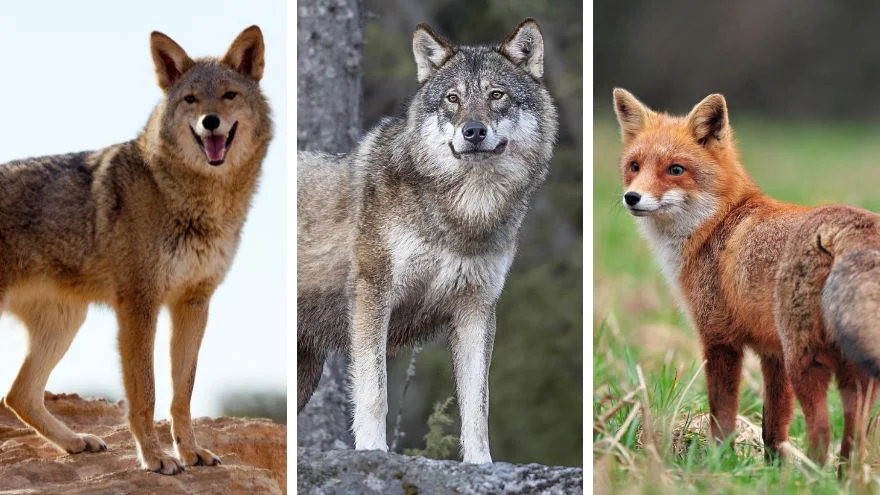To determine the differences between the coyote vs wolf vs fox, we would compare and examine the three very common animals that belong to the Canidae (dog) family.
They’re all relatives of the pet pooch you have at home, and because of their close ties, it can be hard to tell them apart.
You might see a creature darting past you in the woods, and you’d think it’s a wolf when in reality, it is a coyote. Or you might come across a coyote and wonder if it’s a fox.
Wolves, coyotes, and foxes all look alike, hence the misunderstandings. However, these wild dogs do not exactly look alike; they have some significant differences in appearance, behaviors, distribution, and diet.
This article will highlight the significant differences between the wolf, the coyote, and the fox. We’ll also have an overview of each wild dog for more knowledge.
Coyote vs Wolf vs Fox: Comparison and Overview
| Wolf | Coyote | Red Fox | |
|---|---|---|---|
| Scientific Name | Canis lupus | Canis latrans | Vulpes vulpes |
| Height | 80 – 85 cm | 58 – 66 cm | 35 – 50 cm |
| Weight | 23 – 80 kg | 6.8 – 21 kg | 2.2 – 14 kg |
| Length | 1 – 1.6 m | 76 – 86 cm | 45 – 90 cm |
| Colors | White, black, agouti, a mix of white, gray, brown, and black | Mix of gray, light gray, red, peppered black and white mix | Black, silver, a mix of red and silver |
| Lifespan | 10 – 14 yrs | 10 – 14 yrs | 3 – 4 yrs |
Coyote

The coyote is a native of the North American continent, and another name for it is the American jackal. It was also once called the prairie wolf and the brush wolf.
There are 19 different subspecies of the coyote, and it is carnivorous.
The coyote generally has a bad image, though it is wary of humans and attacks are rare.
Wolf

The wolf is also called the gray wolf or grey wolf and can be found in North America, Europe, and Asia.
There are 30 different wolf subspecies, which might explain why they’re popular.
Wolves are social animals as they move in packs, and it is dangerous for a wolf to move alone.
Wolves are also wary of humans, particularly because of bad experiences.
Fox

The fox is a small or medium-sized canid, often depicted as a cunning creature in myths and folklore.
It can be found on every continent except Antarctica, and the most common is the red fox, with around 47 different subspecies.
Related: 600+ Cute Fox Names for Male & Female Foxes
What are the Differences Between Coyotes, Wolves, and Foxes?
1. Taxonomy
Taxonomy refers to how animals are classified based on their features and genetic makeup.
A comparison of these three animals must first begin with taxonomy, as follows:
| Taxonomy | Coyote | Wolf | Fox |
|---|---|---|---|
| Kingdom | Animalia | Animalia | Animalia |
| Phylum | Chordata | Chordata | Chordata |
| Class | Mammalia | Mammalia | Mammalia |
| Order | Carnivora | Carnivora | Carnivora |
| Suborder | Caniformia | Caniformia | Caniformia |
| Family | Canidae | Canidae | Canidae |
| Genus | Canis | Canis | Vulpes |
| Species | Latrans | Lupus, rufus, lycaon | Lagopus, zerda, pallida, cana, chama, corsac, ferrilata, velox, macrotis, ruepelli, bengalensis, Vulpes |
The taxonomy shows us just how closely the coyote, wolf, and fox are related. All are animals, mammals, and in the same Canid family.
The only difference here is in the genus. While the coyote and the wolf are classified under the Canis genus, the fox is in the Vulpes.
Foxes are also of different species, the wolf has three, and there are only one coyote species.
2. Ancestry and Genetics
Going by the taxonomy, it is obvious these wild dogs have a common ancestor.
The split might have happened millions of years back, first between wolves/coyotes and foxes, then between wolves and coyotes.
This could explain why wolves and coyotes still share the same genus and why they can be cross-bred today.
By contrast, you can’t cross-breed foxes with either wolves or coyotes.
3. Size, Colors, and Appearance
The first major difference in physical appearance has to do with size.
Wolves are the biggest canids, measuring up to 11 inches long and weighing 40 to 175 pounds. Coyotes fall short at 9 inches and 25 to 35 pounds in weight. Foxes are the smallest of the three, measuring between 5 and 7 inches long and weighing 7 to 15 pounds.
Wolves, coyotes, and foxes have the same teeth arrangement, but the bite force varies.
Wolves have the strongest bite force, which gets to 1500 PSI. The coyote’s bite force falls between 150 and 175 PSI, while the fox is at 92.
The next difference lies in color. Coyotes are often a combination of different colors.
The back is usually light gray or tan, the hair and bushy tail are dipped black, the underneath is pale cream, and the face might be either grey or reddish brown.
Wolves tend to be gray, while foxes have red and orange fur.
The similarity in all three is that they’re doglike. They have similar pointy ears, tails, canines, and even gait. This is why it’s hard to tell them apart if you don’t draw closer.
4. Personality
Foxes, coyotes, and wolves are all wary of humans, a trait that unites them.
Except provoked or in areas where they might have an advantage, these wild dogs hardly attack. But other behaviors set them apart.
For starters, though foxes fall under the Carnivora order—alongside wolves and coyotes—they are omnivorous.
They can be seen at night looking for a meal. Wolves and coyotes are both carnivores.
Foxes don’t also have the same social life as wolves and coyotes. Some species are solitary, while others have family units. However, they don’t move in packs.
They tend to avoid other foxes that aren’t part of their families. A group of foxes is called a skulk, not a pack.
Wolves and coyotes move in packs. There are some disagreements on whether coyotes have packs, but the consensus is that they do.
You are more likely to find a lone coyote than you would a wolf, however. Solitary hunting isn’t abnormal with coyotes, but it isn’t a good thing with wolves.
5. Distribution and Habitat
The range of these wild dogs varies. We hinted at this in the overview, but let’s compare them here.
Coyotes have the smallest range of all three animals. They are usually situated on the American continent and are found in countries like Canada, the United States, and Mexico.
There are also wolves in the Americas, but their range extends to Europe and Asia. There’s a wolf species in North Africa too.
Foxes are the most widespread of all canids, and they can be found on every continent except Antarctica.
As for habitat, coyotes can be found in many places like forests, grasslands, swamps, and coastal, rural, and urban areas.
Wolves stay in habitats where prey abound. These include forests, tundras, grasslands, deserts, and woodlands.
Foxes are good at adapting and can be found in different habitats like forests, mountains, grasslands, and deserts.
There are some noticeable overlaps in their habitats. All three canids can be found in grasslands and forests.
6. Diet
All three canids are hunters and strong predators. Meat is also a core part of their diet, as you’d expect from wild dogs. They differ in some ways, though.
Coyotes and foxes are scavengers, and foxes are classified as omnivores. Coyotes are carnivorous, but they won’t pass up the opportunity to sometimes eat fruits.
Foxes’ and coyotes’ diets include fruits, berries, rodents, reptiles, and amphibians.
Wolves are total carnivores and apex predators, though they fall prey to some stronger predators and even humans.
Their diet consists of elk, caribou, moose, and some other animals. They hunt in packs and can take down animals bigger than them.
7. Coyote vs Wolf vs Fox: Who Would Win in a Fight?
How do these canids relate? In places where their paths cross, it can sometimes turn into a battle.
Coyotes can attack foxes, though not as a meal. It is sometimes a way of survival. There is no solid evidence of wolves killing foxes, but they do attack coyotes.
Overall, if all three were to get into a fight, the wolf would have a higher chance of victory judging by its physical strength, bite force, predatory skills, and size.
Frequently Asked Questions
Will a coyote fight a fox?
Coyotes are not known to eat foxes, but they do fight and kill the smaller canids if the latter encroaches into their territory and reduces resources. Coyotes are stronger than foxes, so they often win in a fight.
Are coyotes aggressive?
Similar to other wild dogs, coyotes are usually wary of humans and tend to back off. However, there are areas where coyotes have lost their fear of humans, making them more likely to attack.
Are foxes afraid of coyotes?
There are some indications that foxes are wary of coyotes, possibly out of instinct. These two canids are considered natural enemies, regardless of their family ties.
Are wolves and coyotes the same?
Wolves and coyotes look very alike, and it is easy to confuse one for the other. However, they are different species (not subspecies under one species).
Wolves are bigger than coyotes, and some other qualities distinguish them.
What is the difference between a coyote and a fox?
A coyote and a fox are from the same family and share a lot in common, but an observant person would be able to differentiate them. The color, size, and lifestyle differ significantly.
Conclusion
Wolves, foxes, and coyotes are all interesting animals for wildlife enthusiasts, and they all have a part to play in the ecosystem.
They may look alike and share a common ancestry, but some differences make each of them unique.
The differences include physical appearances, behaviors, distribution, and diet.






